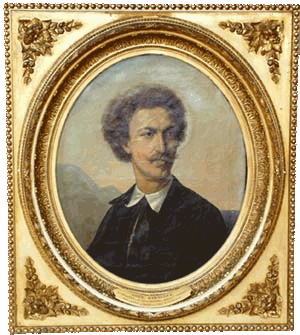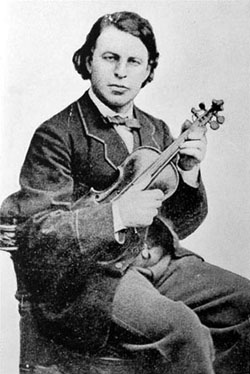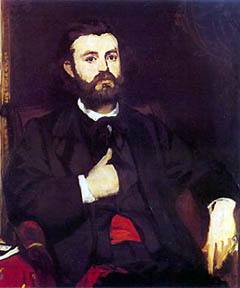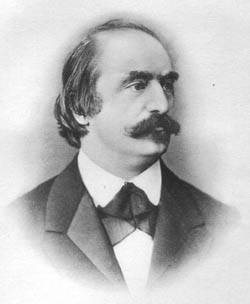Unless otherwise stated all pictures on Berlioz Photos pages have been scanned from engravings, paintings, postcards and other publications in our collection. All rights of reproduction reserved.
This page includes portraits or photographs of the following: Asger Hamerik, Joseph Joachim, Zacharie Astruc, Ferdinand David, and Eduard Hanslick.
![]()

A Danish composer who met Berlioz in Paris in 1864 and was on friendly terms with the composer in his last years. Hamerik liked to present himself as a ‘pupil’ of Berlioz, though Berlioz did not have any ‘pupils’ as such and never sought to found any ‘school’. In the event Hamerik was not as close to Berlioz as were other young musicians such as Saint-Saëns and Théodore Ritter.
The portrait above is by the painter David Jacobsen (1829-71), a Dane and student of Pissarro, working in Paris; dated 1867, the painting was commissioned by Berlioz as a gift to mark his protégé’s successful début in Paris. The work hangs today in the Musical History Museum in Copenhagen, an establishment whose first director was Asger Hamerik’s brother Angul, a distinguished musicologist in his own right. We are most grateful to Mr Christopher Follett for sending us an electronic image of the painting, with the museum’s permission, and the accompanying information.
See further on this site The Danish composer Asger Hamerik and Berlioz by Christopher Follett.

The above photo was published in Alfred Stieglitz, Camera Work, issue number XLI, in January 1913.
Berlioz first heard the great Austro-Hungarian violinist Joseph Joachim in Vienna in 1845-6 and greatly admired him. He considered him a ‘... leading violinist in Germany, perhaps in Europe, and an all-round artist’ (Memoirs). Joachim played in some of Berlioz’s concerts in Germany – a violin concerto and a Paganini caprice in his second concert in Brunswick in October 1853, the solo viola part in Harold in Italy in Bremen in November of the same year, and Rêverie et caprice in Hanover in 1854.

The above picture of Joachim was published in James Davison’s Memoirs, posthumously compiled by his son.

The above portrait by Edouard Manet dates from 1866.
The French sculptor and art critic Zacharie Astruc first met Berlioz in 1859 after he had warmly reviewed a performance of l’Enfance du Christ, and the two men developed a strong mutual liking. Years later Astruc included a mask of Berlioz in his Le Marchand de masques, created in 1883, which is on display in the Jardin du Luxembourg in Paris. The page devoted to that monument gives a detailed account of Berlioz’s relations with Astruc.

The violinist Ferdinand David became leader of the Gewandhaus orchestra under Mendelssohn many years before Berlioz’s first visit to Leipzig in 1843. According to the Memoirs, the ‘eminent musician, composer of merit and distinguished violinist, spoke perfect French and was very helpful’ to Berlioz during both his visits in 1843 and 1853. He also played ‘superbly’ the solo violin in Rêverie et caprice ‘to the audience’s grand applause’ (Memoirs) at Berlioz’s first concert at the Gewandhaus on 4 February 1843.

Hanslick was a music critic, aesthetician, musicologist and civil servant; he was born in Prague but his parental ancestors were German. As a young man Hanslick was enthusiastic about Berlioz’s music, and during his visits to Prague in 1846 was in frequent contact with him. Hanslick later became critical of Berlioz; when in 1879 Stephen Heller published an open letter defending Berlioz against his critics, with his own personal reminiscences of the composer, that letter was addressed ostensibly to Hanslick.
![]()
© (unless otherwise stated) Monir Tayeb and Michel Austin for all the texts and images on Berlioz Photo Album pages.
All rights of reproduction reserved.